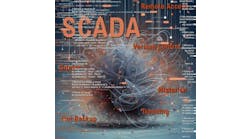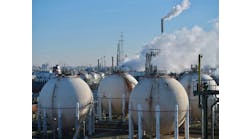Q: Can you trace some of the history of radar and GWR level measurement to give us some context and understanding about the current state of the field?
A: We’ve always sought to make level measurement more accessible and usable, but 25 years ago, radar and GWR were specialty technologies that needed technicians to tweak parameters. This caused them to be used in low quantities, and they weren’t that popular.
Consequently, VEGA created devices that didn’t require users to be technicians to install them or make sure they ran effectively. Plus, we’ve refined them over time, so now users are just asked five questions to set up their radar level system. They’re also more intuitive to operate, so users can focus instead on their process applications, whether they’re lift stations in a water/wastewater plant, grain silos or chemical reactors.
We’ve also added frequencies to make installation less critical. This means level measurement can be more forgiving, and mounting doesn’t have to be perfect. It used to require a lot of engineering to figure out the right mounting in vessels that would provide good level measurements. Now, users can just put them in and they work, which means more users can deploy them.
Q: If more users are deploying radar level measurement, are they doing it in more and different types of applications? If so, how have radar systems evolved to handle these diverse requirements?
A: Today’s radar sensors and system are designed to be mission-specific. For example, sewage lift stations typically run in ambient conditions, so they don’t need high-pressure or high-temperature level measurement. They can usually employ a simple radar solution designed just for that type of process, such as a radar system that runs at 40 psi and 180 °F for $700-$800, instead of the more costly, one-size-fits-all devices of the past.
Meanwhile, if a process requires high-temperature or high-pressure capabilities, we have radar level sensors that can serve at up to 842 °F and 2,300 psi for $8,000-$10,000 because they’re made of Hastelloy or ceramic. Each radar solution is designed to match individual process characteristics, so users can specify what makes the most sense for them. This is why we ask users about, not just their measurement ranges, but the materials they’re processing, and the vessels, reactors and other equipment they’re using. This lets us determine if they really need a high-end sensor, or a product family in the middle, or devices that can handle slurries or solids. All these characteristics are determined by the individual needs of the user’s application.
Q: What kinds of behind-the-scenes technologies enable these diverse radar level measurement capabilities and ease-of-use?
A: It takes some complex engineering to create interfaces for users that are simple. For instance, our second-generation radar chip is designed specifically for level measurement, and doesn’t rely on any commercial, off-the-shelf (COTS) components. This means it’s more adaptable because it can exactly match local frequencies, and it’s easily updated with the right specifications such as built-in diagnostics.
As for networking, even though 95% of output signals are still 4-20 mA with HART, we’re seeing more Ethernet, and Ethernet-Advanced Physical Layer (APL) emerging, too. Ethernet-APL is like two-wire, intrinsically safe (IS), power over Ethernet (PoE) for radar, but it’s less complex than other fieldbus protocols like Foundation Fieldbus or Profibus. Ethernet-APL is similar to 4-20 mA with HART, but it’s much faster, more reliable, and can deliver far more data.
This speed and bandwidth allow users to configure and interrogate their radar level sensors with a web browser. They also enable radar sensors to keep track of their own electronics, measure and manage reliability, monitor voltage at the sensor, and track update rates for how often they’re providing measured values. All of these parameters were already recorded at the source, but now Ethernet or Ethernet-APL can transmit them out. In the future, we’ll get even more values, such as echo curves and other deep diagnostics.
Q: How can users make sense of all these available parameters? How can they determine which ones will be the most beneficial for them, and how can they implement them?
A: Our radar and GWR sensors and systems are easy to implement in safety systems, and they’re also menu-guided. Users only have to answer a few questions, and the device will tell them what proof tests are available. For example, if a user is measuring the ambient water in a tank, the sensor on the vessel takes a measurement when it’s installed, starts a proof test at the push of a button, performs diagnostics, and indicates when the system is ready. Our radar systems tell you what they need, and guide you to it, including indicating which test they require.
In addition, because radar, GWR and other level measurement devices are running microprocessors and making network connections, they also need to establish and maintain cybersecurity. VEGA follows the IEC 62443 standard for the VEGAPULS 6X sensor and in our work processes and facilities because Ethernet and HART protocols are possible avenues for probes and intrusions. Even though intrusions aren’t likely via 4-20 mA, users still need to make sure their devices, operations and facilities are protected, so they can’t be used as points of entry for malware and potential cyber-attacks.
For instance, our VEGAPULS 6X radar level sensor has been certified as compliant with IEC 62443 by the third-party TÜV Sud organization, so users can be sure our devices and their processes are secure. Because users know VEGA’s products and manufacturing are secure, this is one less headache for them to achieve their own IEC 62443 compliance.
Q: What are the best ways for users to learn about these advances in radar and GWR level measurement and the intelligent capabilities they’ve added recently? How can they apply these innovations to their own process applications?
A: We hold classes, lab sessions and exercises via our myVEGA website, but they’re also available in the training center at our new headquarters just north of Cincinnati in Mason, Ohio. This is where users can work with radar and GWR components, push them to the edge, and see how well they’ll operate in their individual level-measurement applications. Customers want to know everything that can happen and how to troubleshoot when it does, and this is where they can receive answers to those questions, and better articulate their specific needs.
Q: How is radar and GWR level measurement instrumentation likely to evolve in the future?
A: Building on the connections and networking we’ve already established, it’s logical that cloud-computing would be next. Consequently, when users are done talking to their radar sensors, they can use the VEGA Tools app on their smartphones or tablets to download sensor data to the cloud, and access and analyze it as needed.
We’re also seeing that Ethernet-APL and the need for cybersecurity are clearly going to keep growing. And, because we know it’s important to be on the cutting edge of these technologies, VEGA will also seek new ways for us and our customers to take advantage of them. Interest in machine learning (ML) and artificial intelligence (AI) is high, so we’re carefully examining those technologies as well.





